sensor HONDA PILOT 2016 3.G Quick Guide
[x] Cancel search | Manufacturer: HONDA, Model Year: 2016, Model line: PILOT, Model: HONDA PILOT 2016 3.GPages: 89, PDF Size: 5.82 MB
Page 4 of 89
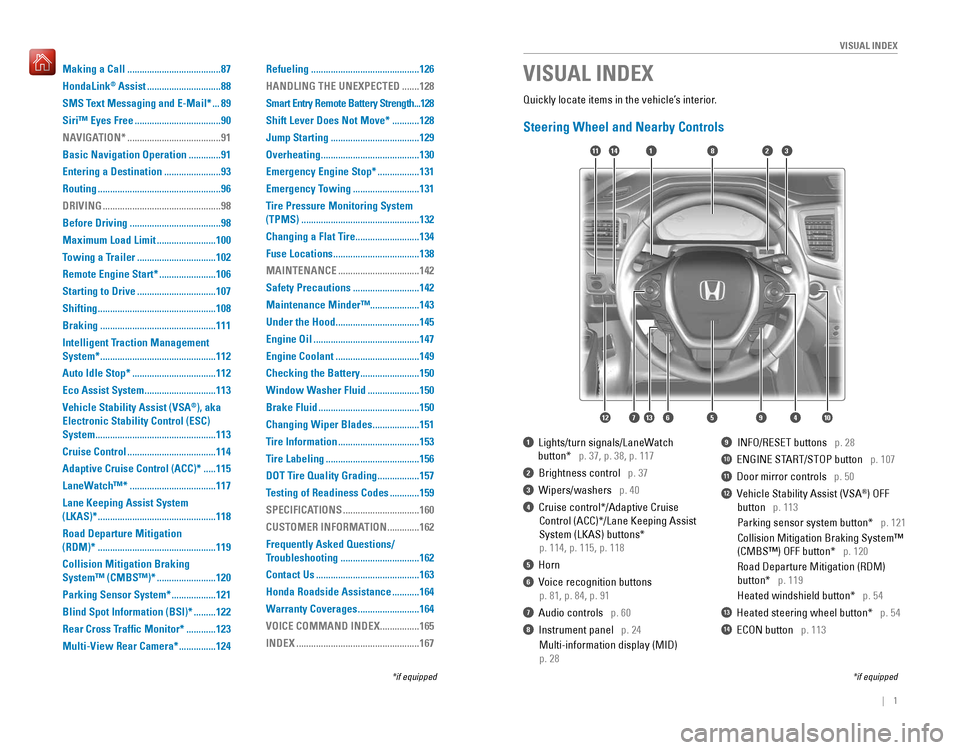
| 1
VISUAL INDEX
Quickly locate items in the vehicle’s interior.
Steering Wheel and Nearby Controls
1 Lights/turn signals/LaneWatch
button* p. 37, p. 38, p. 117
2 Brightness control p. 37
3 Wipers/washers p. 40
4 Cruise control*/Adaptive Cruise
Control (ACC)*/Lane Keeping Assist
System (LKAS) buttons*
p. 114, p. 115, p. 118
5 Horn
6 Voice recognition buttons
p. 81, p. 84, p. 91
7 Audio controls p. 60
8 Instrument panel p. 24
Multi-information display (MID)
p. 28
9 INFO/RESET buttons p. 28
10 ENGINE START/STOP button p. 107
11 Door mirror controls p. 50
12 Vehicle Stability Assist (VSA®) OFF
button p. 113
Parking sensor system button* p. 121
Collision Mitigation Braking System™
(CMBS™) OFF button* p. 120
Road Departure Mitigation (RDM)
button* p. 119
Heated windshield button* p. 54
13 Heated steering wheel button* p. 54
14 ECON button p. 113
VISUAL INDEX
*if equipped
*if equipped
1
74596131210
1114823
Making a Call ......................................87
HondaLink
® Assist ..............................88
SMS Text Messaging and E-Mail*
...89
Siri™ Eyes Free
...................................90
NAVIGATION*
......................................91
Basic Navigation Operation
.............91
Entering a Destination
.......................93
Routing
..................................................96
DRIVING
................................................98
Before Driving
.....................................98
Maximum Load Limit
........................100
Towing a Trailer
................................102
Remote Engine Start*
.......................106
Starting to Drive
................................107
Shifting
................................................108
Braking
...............................................111
Intelligent Traction Management
System*
...............................................112
Auto Idle Stop*
..................................112
Eco Assist System
.............................113
Vehicle Stability Assist (VSA
®), aka
Electronic Stability Control (ESC)
System
.................................................113
Cruise Control
....................................114
Adaptive Cruise Control (ACC)*
.....115
LaneWatch™*
...................................117
Lane Keeping Assist System
(LKAS)*
................................................118
Road Departure Mitigation
(RDM)*
................................................119
Collision Mitigation Braking
System™ (CMBS™)*
........................120
Parking Sensor System*
..................121
Blind Spot Information (BSI)*
.........122
Rear Cross Traffic Monitor*
............123
Multi-View Rear Camera*
...............124 Refueling
............................................126
HANDLING THE UNEXPECTED
.......128
Smart Entry Remote Battery Strength
...128
Shift Lever Does Not Move*
...........128
Jump Starting
....................................129
Overheating
........................................130
Emergency Engine Stop*
.................131
Emergency Towing
...........................131
Tire Pressure Monitoring System
(TPMS)
................................................132
Changing a Flat Tire
..........................134
Fuse Locations
...................................138
MAINTENANCE
.................................142
Safety Precautions
...........................142
Maintenance Minder™ ....................143
Under the Hood
..................................145
Engine Oil
...........................................147
Engine Coolant
..................................149
Checking the Battery
........................150
Window Washer Fluid
.....................150
Brake Fluid
.........................................150
Changing Wiper Blades
...................151
Tire Information
.................................153
Tire Labeling
......................................156
DOT Tire Quality Grading
.................157
Testing of Readiness Codes
............159
SPECIFICATIONS
...............................160
CUSTOMER INFORMATION
.............162
Frequently Asked Questions/
Troubleshooting
................................162
Contact Us
..........................................163
Honda Roadside Assistance
...........164
Warranty Coverages
.........................164
VOICE COMMAND INDEX
................165
INDEX
..................................................167
Page 8 of 89
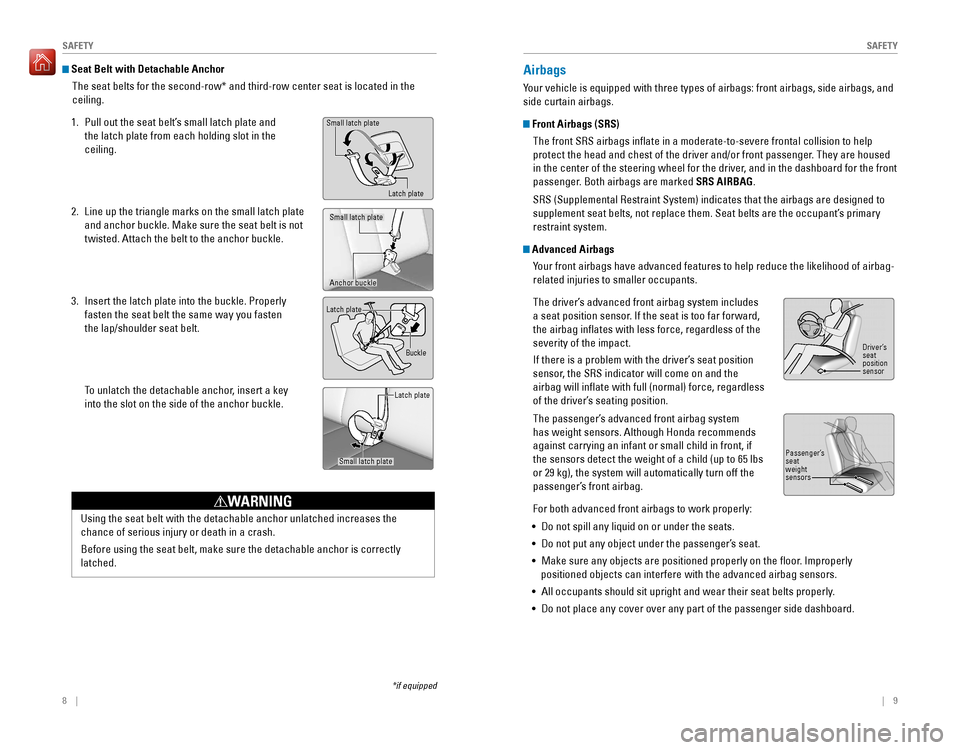
8 || 9
SAFETYSAFETY
Seat Belt with Detachable Anchor
The seat belts for the second-row* and third-row center seat is located \
in the
ceiling.
1. Pull out the seat belt’s small latch plate and
the latch plate from each holding slot in the
ceiling.
2. Line up the triangle marks on the small latch plate
and anchor buckle. Make sure the seat belt is not
twisted. Attach the belt to the anchor buckle.
3. Insert the latch plate into the buckle. Properly
fasten the seat belt the same way you fasten
the lap/shoulder seat belt.
To unlatch the detachable anchor, insert a key
into the slot on the side of the anchor buckle.
Latch plate
Buckle
Airbags
Your vehicle is equipped with three types of airbags: front airbags, side\
airbags, and
side curtain airbags.
Front Airbags (SRS)The front SRS airbags inflate in a moderate-to-severe frontal collisio\
n to help
protect the head and chest of the driver and/or front passenger. They are housed
in the center of the steering wheel for the driver, and in the dashboard for the front
passenger. Both airbags are marked SRS AIRBAG.
SRS (Supplemental Restraint System) indicates that the airbags are des\
igned to
supplement seat belts, not replace them. Seat belts are the occupant’\
s primary
restraint system.
Advanced AirbagsYour front airbags have advanced features to help reduce the likelihood o\
f airbag-
related injuries to smaller occupants.
The driver’s advanced front airbag system includes
a seat position sensor. If the seat is too far forward,
the airbag inflates with less force, regardless of the
severity of the impact.
If there is a problem with the driver’s seat position
sensor, the SRS indicator will come on and the
airbag will inflate with full (normal) force, regardless
of the driver’s seating position.
The passenger’s advanced front airbag system
has weight sensors. Although Honda recommends
against carrying an infant or small child in front, if
the sensors detect the weight of a child (up to 65 lbs
or 29 kg), the system will automatically turn off the
passenger’s front airbag.
For both advanced front airbags to work properly:
• Do not spill any liquid on or under the seats.
• Do not put any object under the passenger’s seat.
• Make sure any objects are positioned properly on the floor. Improperly
positioned objects can interfere with the advanced airbag sensors.
• All occupants should sit upright and wear their seat belts properly.
• Do not place any cover over any part of the passenger side dashboard.
Driver’sseat
position
sensor
Passenger’s
seat
weight
sensors
Using the seat belt with the detachable anchor unlatched increases the
chance of serious injury or death in a crash.
Before using the seat belt, make sure the detachable anchor is correctly\
latched.
WARNING
Small latch plate Latch plate
Small latch plate
Anchor buckle
Small latch plate Latch plate
*if equipped
Page 10 of 89
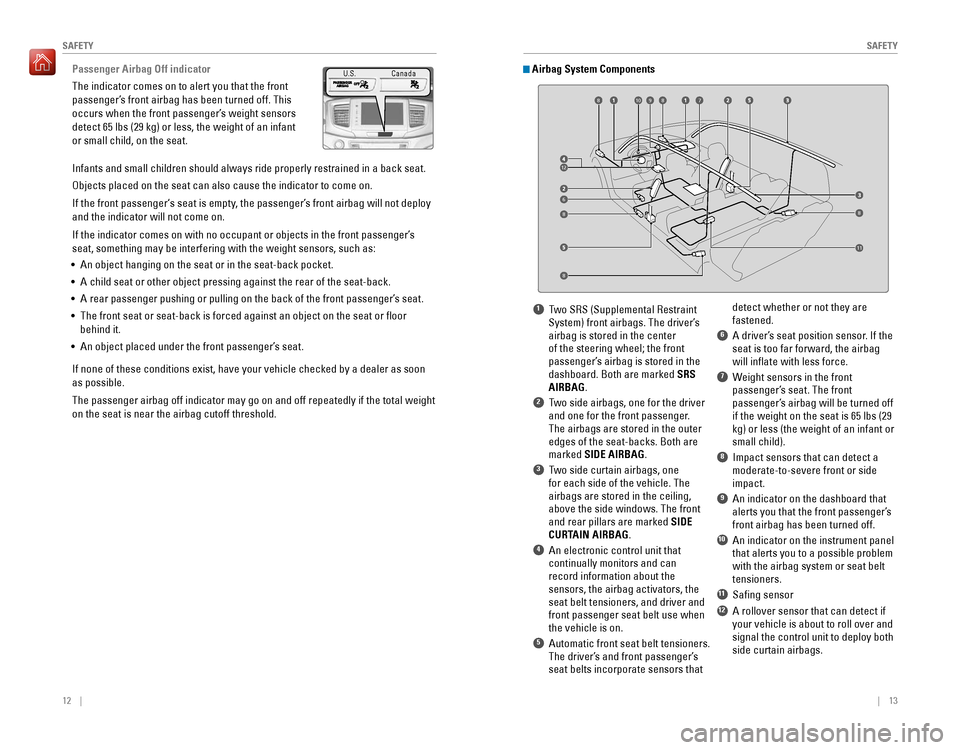
12 || 13
SAFETYSAFETY
Passenger Airbag Off indicator
The indicator comes on to alert you that the front
passenger’s front airbag has been turned off. This
occurs when the front passenger’s weight sensors
detect 65 lbs (29 kg) or less, the weight of an infant
or small child, on the seat.
Infants and small children should always ride properly restrained in a b\
ack seat.
Objects placed on the seat can also cause the indicator to come on.
If the front passenger‘s seat is empty, the passenger’s front airbag will not deploy
and the indicator will not come on.
If the indicator comes on with no occupant or objects in the front passe\
nger’s
seat, something may be interfering with the weight sensors, such as:
• An object hanging on the seat or in the seat-back pocket.
• A child seat or other object pressing against the rear of the seat-back.\
• A rear passenger pushing or pulling on the back of the front passenger’\
s seat.
• The front seat or seat-back is forced against an object on the seat or fl\
oor
behind it.
• An object placed under the front passenger’s seat.
If none of these conditions exist, have your vehicle checked by a dealer\
as soon
as possible.
The passenger airbag off indicator may go on and off repeatedly if the t\
otal weight
on the seat is near the airbag cutoff threshold.
1 Two SRS (Supplemental Restraint System) front airbags. The driver’s
airbag is stored in the center
of the steering wheel; the front
passenger’s airbag is stored in the
dashboard. Both are marked SRS
AIRBAG.
2 Two side airbags, one for the driver and one for the front passenger.
The airbags are stored in the outer
edges of the seat-backs. Both are
marked SIDE AIRBAG.
3 Two side curtain airbags, one for each side of the vehicle. The
airbags are stored in the ceiling,
above the side windows. The front
and rear pillars are marked SIDE
CURTAIN AIRBAG.
4 An electronic control unit that continually monitors and can
record information about the
sensors, the airbag activators, the
seat belt tensioners, and driver and
front passenger seat belt use when
the vehicle is on.
5 Automatic front seat belt tensioners. The driver’s and front passenger’s
seat belts incorporate sensors that detect whether or not they are
fastened.
6 A driver’s seat position sensor. If the
seat is too far forward, the airbag
will inflate with less force.
7 Weight sensors in the front passenger’s seat. The front
passenger’s airbag will be turned off
if the weight on the seat is 65 lbs (29
kg) or less (the weight of an infant or
small child).
8 Impact sensors that can detect a moderate-to-severe front or side
impact.
9 An indicator on the dashboard that alerts you that the front passenger’s
front airbag has been turned off.
10 An indicator on the instrument panel that alerts you to a possible problem
with the airbag system or seat belt
tensioners.
11 Safing sensor
12 A rollover sensor that can detect if your vehicle is about to roll over and
signal the control unit to deploy both
side curtain airbags.
Airbag System Components
12
6
79108
88
8
11
8
U.S. Canada
Page 11 of 89
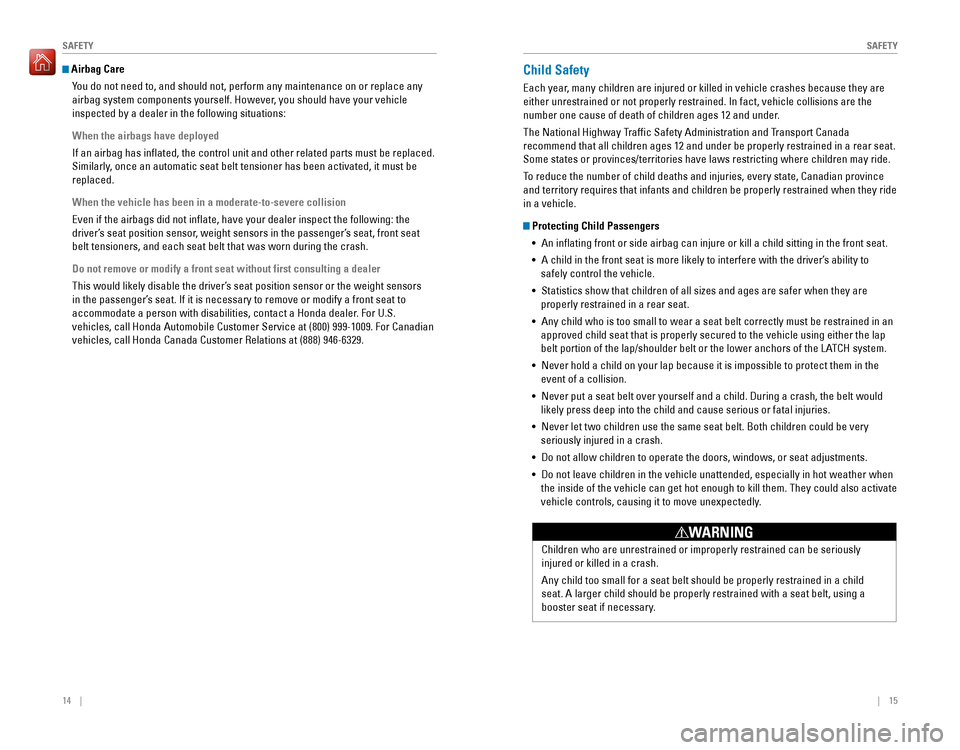
14 || 15
SAFETYSAFETY
Airbag Care
You do not need to, and should not, perform any maintenance on or replace\
any
airbag system components yourself. However, you should have your vehicle
inspected by a dealer in the following situations:
When the airbags have deployed
If an airbag has inflated, the control unit and other related parts mu\
st be replaced.
Similarly, once an automatic seat belt tensioner has been activated, it must be
replaced.
When the vehicle has been in a moderate-to-severe collision
Even if the airbags did not inflate, have your dealer inspect the foll\
owing: the
driver’s seat position sensor, weight sensors in the passenger’s seat, front seat
belt tensioners, and each seat belt that was worn during the crash.
Do not remove or modify a front seat without first consulting a dealer
This would likely disable the driver’s seat position sensor or the weight sensors
in the passenger’s seat. If it is necessary to remove or modify a front seat to
accommodate a person with disabilities, contact a Honda dealer. For U.S.
vehicles, call Honda Automobile Customer Service at (800) 999-1009. Fo\
r Canadian
vehicles, call Honda Canada Customer Relations at (888) 946-6329.Child Safety
Each year, many children are injured or killed in vehicle crashes because they are
either unrestrained or not properly restrained. In fact, vehicle collisi\
ons are the
number one cause of death of children ages 12 and under.
The National Highway Traffic Safety Administration and Transport Canada
recommend that all children ages 12 and under be properly restrained in \
a rear seat.
Some states or provinces/territories have laws restricting where childre\
n may ride.
To reduce the number of child deaths and injuries, every state, Canadian \
province
and territory requires that infants and children be properly restrained \
when they ride
in a vehicle.
Protecting Child Passengers• An inflating front or side airbag can injure or kill a child sitting i\
n the front seat.
• A child in the front seat is more likely to interfere with the driver’\
s ability to
safely control the vehicle.
• Statistics show that children of all sizes and ages are safer when they \
are
properly restrained in a rear seat.
• Any child who is too small to wear a seat belt correctly must be restrai\
ned in an
approved child seat that is properly secured to the vehicle using either\
the lap
belt portion of the lap/shoulder belt or the lower anchors of the LATCH system.
• Never hold a child on your lap because it is impossible to protect them \
in the
event of a collision.
• Never put a seat belt over yourself and a child. During a crash, the bel\
t would
likely press deep into the child and cause serious or fatal injuries.
• Never let two children use the same seat belt. Both children could be ve\
ry
seriously injured in a crash.
• Do not allow children to operate the doors, windows, or seat adjustments\
.
• Do not leave children in the vehicle unattended, especially in hot weath\
er when
the inside of the vehicle can get hot enough to kill them. They could al\
so activate
vehicle controls, causing it to move unexpectedly.
Children who are unrestrained or improperly restrained can be seriously \
injured or killed in a crash.
Any child too small for a seat belt should be properly restrained in a c\
hild
seat. A larger child should be properly restrained with a seat belt, usi\
ng a
booster seat if necessary.
WARNING
Page 16 of 89
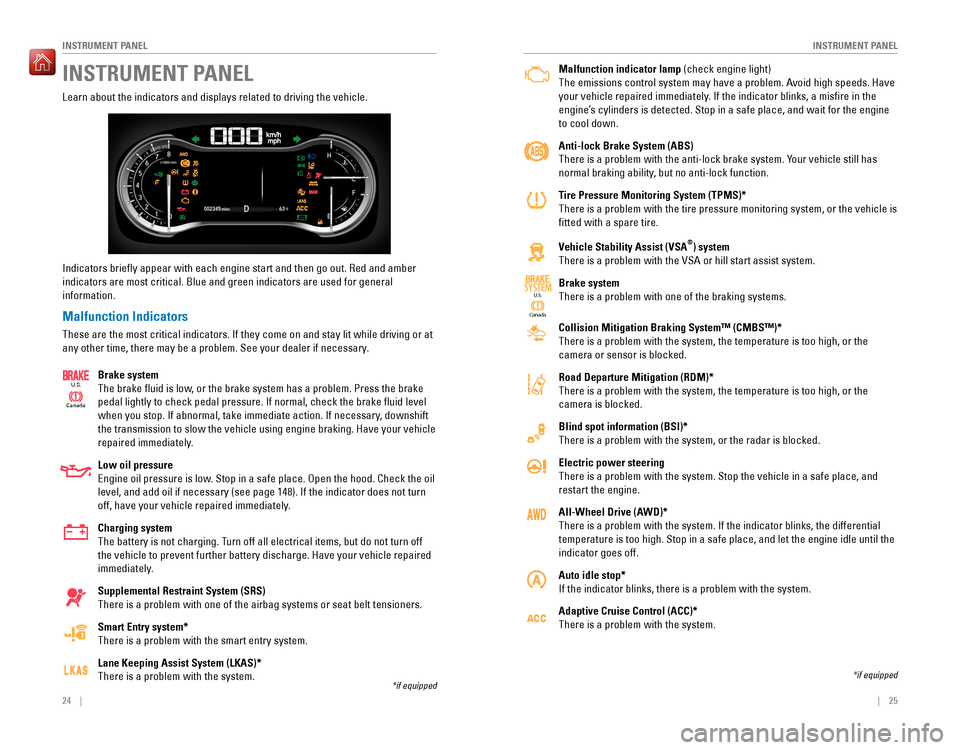
24 || 25
INSTRUMENT PANELINSTRUMENT PANEL
Learn about the indicators and displays related to driving the vehicle.
Indicators briefly appear with each engine start and then go out. Red \
and amber
indicators are most critical. Blue and green indicators are used for gen\
eral
information.
Malfunction Indicators
These are the most critical indicators. If they come on and stay lit whi\
le driving or at
any other time, there may be a problem. See your dealer if necessary.
Brake system
The brake fluid is low, or the brake system has a problem. Press the brake
pedal lightly to check pedal pressure. If normal, check the brake flui\
d level
when you stop. If abnormal, take immediate action. If necessary, downshift
the transmission to slow the vehicle using engine braking. Have your vehicle
repaired immediately.
Low oil pressure
Engine oil pressure is low. Stop in a safe place. Open the hood. Check the oil
level, and add oil if necessary (see page 148). If the indicator does \
not turn
off, have your vehicle repaired immediately.
Charging system
The battery is not charging. Turn off all electrical items, but do not turn off
the vehicle to prevent further battery discharge. Have your vehicle repa\
ired
immediately.
Supplemental Restraint System (SRS)
There is a problem with one of the airbag systems or seat belt tensioner\
s.
Smart Entry system*
There is a problem with the smart entry system.
Lane Keeping Assist System (LKAS)*
There is a problem with the system.
INSTRUMENT PANEL
Canada
U.S.
*if equipped
Malfunction indicator lamp (check engine light)
The emissions control system may have a problem. Avoid high speeds. Have
your vehicle repaired immediately. If the indicator blinks, a misfire in the
engine’s cylinders is detected. Stop in a safe place, and wait for the engine
to cool down.
Anti-lock Brake System (ABS)
There is a problem with the anti-lock brake system. Your vehicle still has
normal braking ability, but no anti-lock function.
Tire Pressure Monitoring System (TPMS)*
There is a problem with the tire pressure monitoring system, or the vehi\
cle is
fitted with a spare tire.
Vehicle Stability Assist (VSA
®) system
There is a problem with the VSA or hill start assist system.
Brake system
There is a problem with one of the braking systems.
Collision Mitigation Braking System™ (CMBS™)*
There is a problem with the system, the temperature is too high, or the \
camera or sensor is blocked.
Road Departure Mitigation (RDM)*
There is a problem with the system, the temperature is too high, or the \
camera is blocked.
Blind spot information (BSI)*
There is a problem with the system, or the radar is blocked.
Electric power steering
There is a problem with the system. Stop the vehicle in a safe place, an\
d
restart the engine.
All-Wheel Drive (AWD)*
There is a problem with the system. If the indicator blinks, the differe\
ntial
temperature is too high. Stop in a safe place, and let the engine idle u\
ntil the
indicator goes off.
Auto idle stop*
If the indicator blinks, there is a problem with the system.
Adaptive Cruise Control (ACC)*
There is a problem with the system.
Ca nada
U.S.SYSTEM
*if equipped
Page 24 of 89
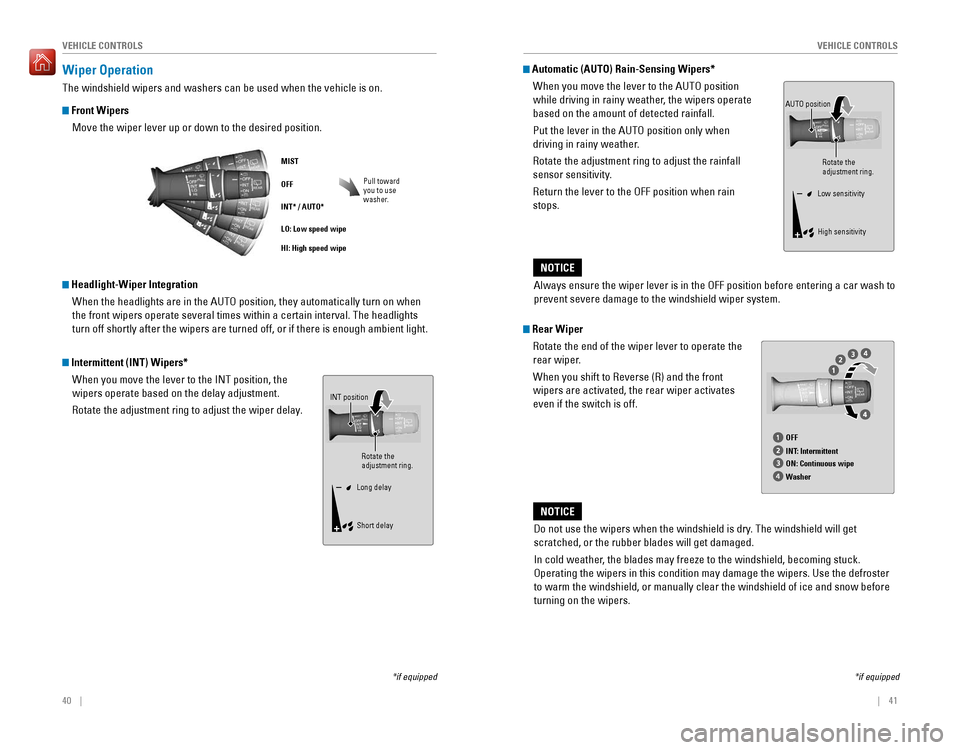
40 || 41
VEHICLE CONTROLSVEHICLE CONTROLS
Wiper Operation
The windshield wipers and washers can be used when the vehicle is on.
Front Wipers
Move the wiper lever up or down to the desired position.
Pull toward you to use
washer.
MIST
OFF
INT* / AUTO*
LO: Low speed wipe
HI: High speed wipe
*if equipped
Always ensure the wiper lever is in the OFF position before entering a c\
ar wash to
prevent severe damage to the windshield wiper system.
NOTICE
Do not use the wipers when the windshield is dry. The windshield will get
scratched, or the rubber blades will get damaged.
In cold weather, the blades may freeze to the windshield, becoming stuck.
Operating the wipers in this condition may damage the wipers. Use the de\
froster
to warm the windshield, or manually clear the windshield of ice and snow before
turning on the wipers.
NOTICE
Rear Wiper Rotate the end of the wiper lever to operate the
rear wiper.
When you shift to Reverse (R) and the front
wipers are activated, the rear wiper activates
even if the switch is off.
INT: Intermittent
OFF
Washer ON: Continuous wipe
Intermittent (INT) Wipers*When you move the lever to the INT position, the
wipers operate based on the delay adjustment.
Rotate the adjustment ring to adjust the wiper delay.
Headlight-Wiper IntegrationWhen the headlights are in the AUTO position, they automatically turn on\
when
the front wipers operate several times within a certain interval. The he\
adlights
turn off shortly after the wipers are turned off, or if there is enough \
ambient light.
Automatic (AUTO) Rain-Sensing Wipers*When you move the lever to the AUTO position
while driving in rainy weather, the wipers operate
based on the amount of detected rainfall.
Put the lever in the AUTO position only when
driving in rainy weather.
Rotate the adjustment ring to adjust the rainfall
sensor sensitivity.
Return the lever to the OFF position when rain
stops.
Rotate the adjustment ring.
Long delay
Short delay
INT position
Rotate the adjustment ring.
Low sensitivity
High sensitivity
AUTO position
*if equipped
Page 33 of 89
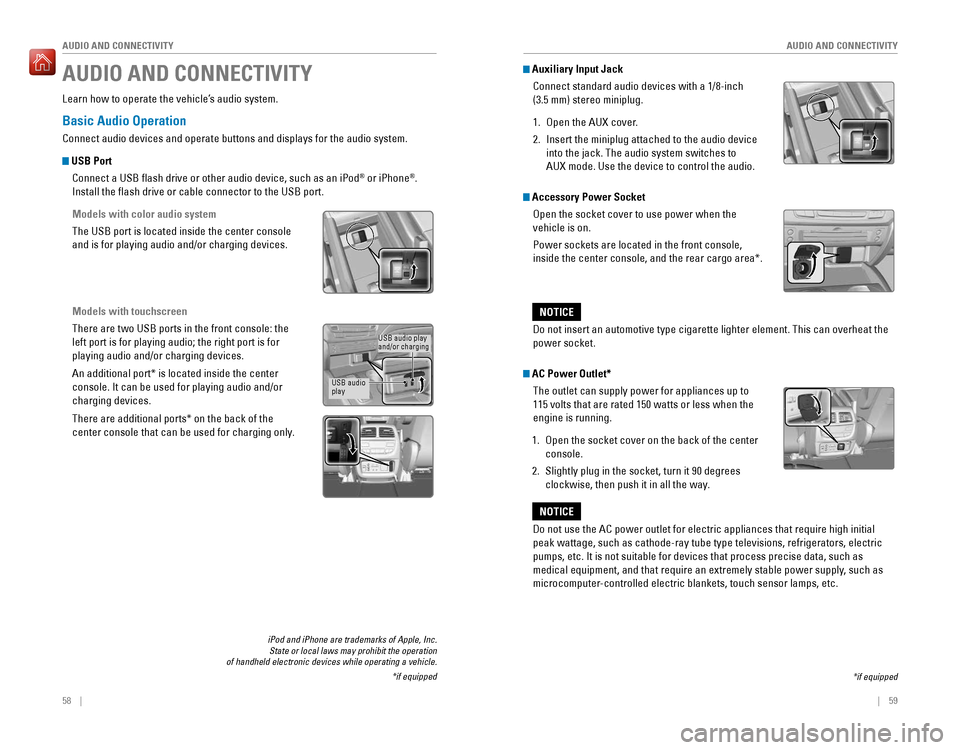
58 || 59
AUDIO AND CONNECTIVITY
AUDIO AND CONNECTIVITY
Basic Audio Operation
Connect audio devices and operate buttons and displays for the audio sys\
tem.
USB Port
Connect a USB flash drive or other audio device, such as an iPod
® or iPhone®.
Install the flash drive or cable connector to the USB port.
Models with color audio system
The USB port is located inside the center console
and is for playing audio and/or charging devices.
Models with touchscreen
There are two USB ports in the front console: the
left port is for playing audio; the right port is for
playing audio and/or charging devices.
An additional port* is located inside the center
console. It can be used for playing audio and/or
charging devices.
There are additional ports* on the back of the
center console that can be used for charging only.
iPod and iPhone are trademarks of Apple, Inc. State or local laws may prohibit the operation
of handheld electronic devices while operating a vehicle.
*if equipped
AUDIO AND CONNECTIVITY
Learn how to operate the vehicle’s audio system.
USB audio play
and/or charging
USB audio
play
*if equipped
Accessory Power Socket Open the socket cover to use power when the
vehicle is on.
Power sockets are located in the front console,
inside the center console, and the rear cargo area*.
Do not insert an automotive type cigarette lighter element. This can ove\
rheat the
power socket.
NOTICE
AC Power Outlet*The outlet can supply power for appliances up to
115 volts that are rated 150 watts or less when the
engine is running.
1. Open the socket cover on the back of the center
console.
2. Slightly plug in the socket, turn it 90 degrees
clockwise, then push it in all the way.
Do not use the AC power outlet for electric appliances that require high\
initial
peak wattage, such as cathode-ray tube type televisions, refrigerators, \
electric
pumps, etc. It is not suitable for devices that process precise data, su\
ch as
medical equipment, and that require an extremely stable power supply, such as
microcomputer-controlled electric blankets, touch sensor lamps, etc.
NOTICE
Auxiliary Input JackConnect standard audio devices with a 1/8-inch
(3.5 mm) stereo miniplug.
1. Open the AUX cover.
2. Insert the miniplug attached to the audio device
into the jack. The audio system switches to
AUX mode. Use the device to control the audio.
Page 64 of 89
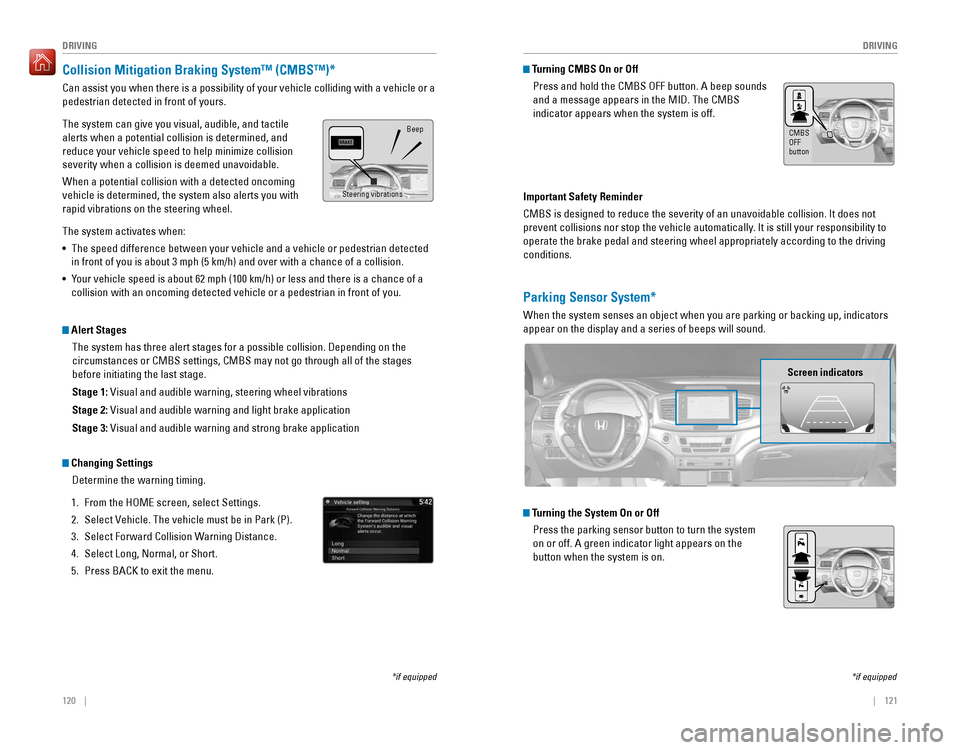
120 || 121
DRIVING
DRIVING
Collision Mitigation Braking System™ (CMBS™)*
Can assist you when there is a possibility of your vehicle colliding wit\
h a vehicle or a
pedestrian detected in front of yours.
The system can give you visual, audible, and tactile
alerts when a potential collision is determined, and
reduce your vehicle speed to help minimize collision
severity when a collision is deemed unavoidable.
When a potential collision with a detected oncoming
vehicle is determined, the system also alerts you with
rapid vibrations on the steering wheel.
The system activates when:
• The speed difference between your vehicle and a vehicle or pedestrian de\
tected
in front of you is about 3 mph (5 km/h) and over with a chance of a co\
llision.
• Your vehicle speed is about 62 mph (100 km/h) or less and there is a ch\
ance of a
collision with an oncoming detected vehicle or a pedestrian in front of \
you.
Changing Settings
Determine the warning timing.
1. From the HOME screen, select Settings.
2. Select Vehicle. The vehicle must be in Park (P).
3. Select Forward Collision Warning Distance.
4. Select Long, Normal, or Short.
5. Press BACK to exit the menu.
*if equipped
Alert StagesThe system has three alert stages for a possible collision. Depending on\
the
circumstances or CMBS settings, CMBS may not go through all of the stage\
s
before initiating the last stage.
Stage 1: Visual and audible warning, steering wheel vibrations
Stage 2: Visual and audible warning and light brake application
Stage 3: Visual and audible warning and strong brake application
Beep
Steering vibrationsImportant Safety Reminder
CMBS is designed to reduce the severity of an unavoidable collision. It \
does not
prevent collisions nor stop the vehicle automatically. It is still your responsibility to
operate the brake pedal and steering wheel appropriately according to th\
e driving
conditions.
Turning CMBS On or OffPress and hold the CMBS OFF button. A beep sounds
and a message appears in the MID. The CMBS
indicator appears when the system is off.
CMBS OFF
button
Parking Sensor System*
When the system senses an object when you are parking or backing up, ind\
icators
appear on the display and a series of beeps will sound.
Turning the System On or OffPress the parking sensor button to turn the system
on or off. A green indicator light appears on the
button when the system is on.
Screen indicators
*if equipped
Page 79 of 89
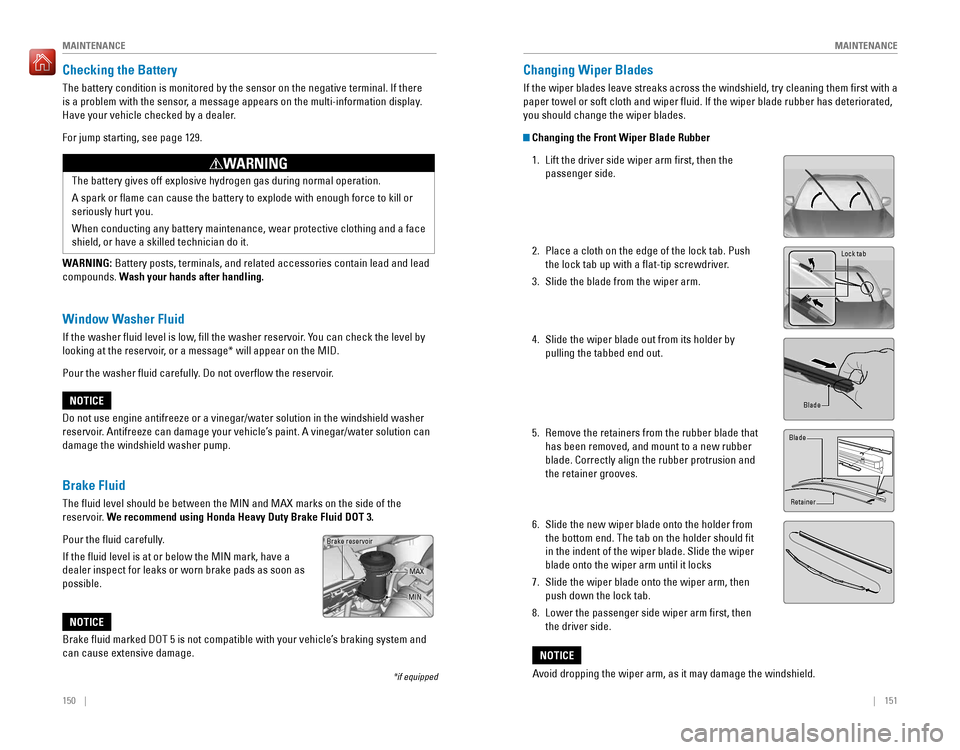
150 || 151
MAINTENANCE
MAINTENANCE
Checking the Battery
The battery condition is monitored by the sensor on the negative termina\
l. If there
is a problem with the sensor, a message appears on the multi-information display.
Have your vehicle checked by a dealer.
For jump starting, see page 129.
The battery gives off explosive hydrogen gas during normal operation.
A spark or flame can cause the battery to explode with enough force to\
kill or
seriously hurt you.
When conducting any battery maintenance, wear protective clothing and a \
face
shield, or have a skilled technician do it.
WARNING
WARNING: Battery posts, terminals, and related accessories contain lead and lead\
compounds. Wash your hands after handling.
Window Washer Fluid
If the washer fluid level is low, fill the washer reservoir. You can check the level by
looking at the reservoir, or a message* will appear on the MID.
Pour the washer fluid carefully. Do not overflow the reservoir.
Do not use engine antifreeze or a vinegar/water solution in the windshie\
ld washer
reservoir. Antifreeze can damage your vehicle’s paint. A vinegar/water solution can
damage the windshield washer pump.
NOTICE
Brake Fluid
The fluid level should be between the MIN and MAX marks on the side of\
the
reservoir. We recommend using Honda Heavy Duty Brake Fluid DOT 3.
Pour the fluid carefully.
If the fluid level is at or below the MIN mark, have a
dealer inspect for leaks or worn brake pads as soon as
possible.
Brake fluid marked DOT 5 is not compatible with your vehicle’s braking system and
can cause extensive damage.
NOTICE
*if equipped
Brake reservoir MAX
MIN
Changing Wiper Blades
If the wiper blades leave streaks across the windshield, try cleaning th\
em first with a
paper towel or soft cloth and wiper fluid. If the wiper blade rubber h\
as deteriorated,
you should change the wiper blades.
Changing the Front Wiper Blade Rubber
1. Lift the driver side wiper arm first, then the
passenger side.
2. Place a cloth on the edge of the lock tab. Push
the lock tab up with a flat-tip screwdriver.
3. Slide the blade from the wiper arm.
4. Slide the wiper blade out from its holder by
pulling the tabbed end out.
5. Remove the retainers from the rubber blade that
has been removed, and mount to a new rubber
blade. Correctly align the rubber protrusion and
the retainer grooves.
6. Slide the new wiper blade onto the holder from
the bottom end. The tab on the holder should fit
in the indent of the wiper blade. Slide the wiper
blade onto the wiper arm until it locks
7. Slide the wiper blade onto the wiper arm, then
push down the lock tab.
8. Lower the passenger side wiper arm first, then
the driver side.
Lock tab
Blade
Retainer
Avoid dropping the wiper arm, as it may damage the windshield.
NOTICE
Blade
Page 88 of 89
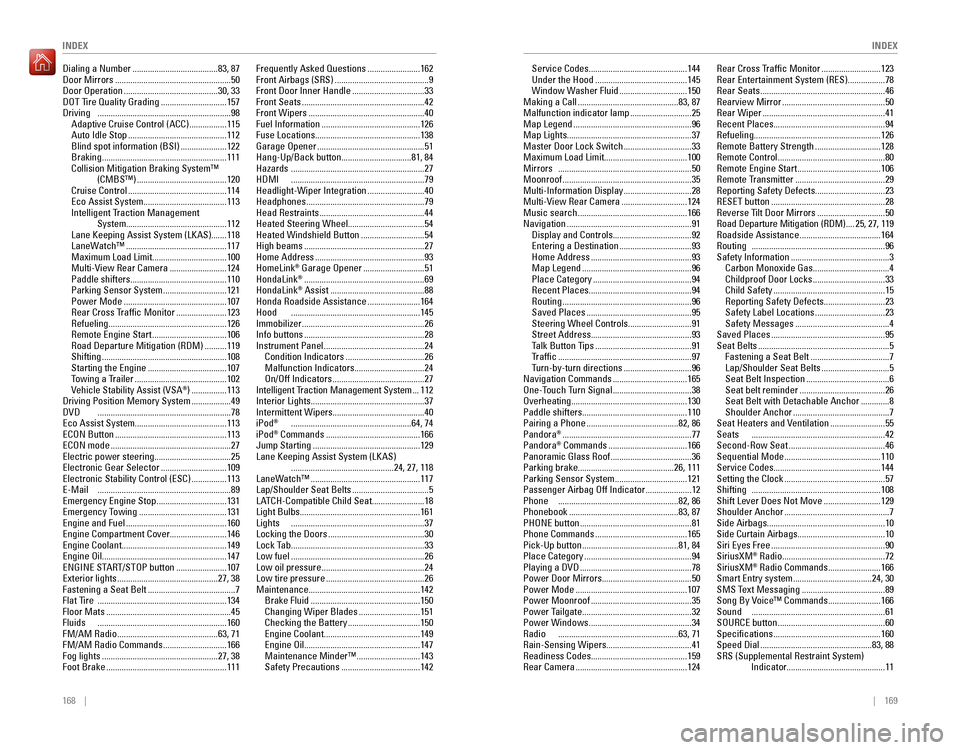
168 || 169
INDEX
INDEX
Dialing a Number .......................................83, 87
Door Mirrors .....................................................50
Door Operation ...........................................30, 33
DOT Tire Quality Grading ..............................157Driving .............................................................98
Adaptive Cruise Control (ACC) .................115
Auto Idle Stop .............................................112
Blind spot information (BSI) .....................122
Braking .........................................................111
Collision Mitigation Braking System™ (CMBS™)
.........................................120
Cruise Control .............................................114
Eco Assist System ......................................113
Intelligent Traction Management System .............................................. 112
Lane Keeping Assist System (LKAS)
.......118
LaneWatch™ ..............................................117
Maximum Load Limit ..................................100
Multi-View Rear Camera ..........................124
Paddle shifters ............................................110
Parking Sensor System .............................121
Power Mode ...............................................107
Rear Cross Traffic Monitor .......................123
Refueling ......................................................126
Remote Engine Start ..................................106
Road Departure Mitigation (RDM) ..........119
Shifting .........................................................108
Starting the Engine ....................................107
Towing a Trailer ..........................................102
Vehicle Stability Assist (VSA®) ................113
Driving Position Memory System ..................49DVD .............................................................78
Eco Assist System .......................................... 113
ECON Button
...................................................113
ECON mode .......................................................27
Electric power steering ...................................25
Electronic Gear Selector
..............................109
Electronic Stability Control (ESC) ................113E-Mail .............................................................89
Emergency Engine Stop ................................131
Emergency Towing ........................................131
Engine and Fuel ..............................................160
Engine Compartment Cover ..........................146
Engine Coolant ................................................ 149
Engine Oil ......................................................... 147
ENGINE START/STOP button
.......................107
Exterior lights ..............................................27, 38
Fastening a Seat Belt ........................................7Flat Tire ...........................................................134
Floor Mats .........................................................45Fluids ...........................................................160
FM/AM Radio ..............................................63, 71
FM/AM Radio Commands .............................166
Fog lights .....................................................27, 38
Foot Brake .......................................................111 Frequently Asked Questions
........................162
Front Airbags (SRS) ...........................................9
Front Door Inner Handle .................................33
Front Seats ........................................................42
Front Wipers .....................................................40
Fuel Information .............................................126
Fuse Locations ................................................ 138
Garage Opener
.................................................51
Hang-Up/Back button ................................81, 84
Hazards .............................................................27HDMI .............................................................79
Headlight-Wiper Integration ..........................40
Headphones ......................................................79
Head Restraints ................................................44
Heated Steering Wheel ...................................54
Heated Windshield Button
.............................54
High beams .......................................................27
Home Address ..................................................93
HomeLink® Garage Opener ............................51
HondaLink® .......................................................69
HondaLink® Assist ...........................................88
Honda Roadside Assistance ........................164Hood ...........................................................145
Immobilizer ........................................................26
Info buttons .......................................................28
Instrument Panel ..............................................24
Condition Indicators ....................................26
Malfunction Indicators ................................24
On/Off Indicators ..........................................27
Intelligent Traction Management System ...112
Interior Lights .................................................... 37
Intermittent Wipers .......................................... 40
iPod
® .......................................................64, 74
iPod® Commands ...........................................166
Jump Starting .................................................129
Lane Keeping Assist System (LKAS)
...............................................24, 27, 118
LaneWatch™ ..................................................117
Lap/Shoulder Seat Belts ...................................5
LATCH-Compatible Child Seat ........................18
Light Bulbs ....................................................... 161
Lights .............................................................37
Locking the Doors ............................................30
Lock Tab .............................................................33Low fuel .............................................................26
Low oil pressure ...............................................24
Low tire pressure .............................................26
Maintenance ................................................... 142
Brake Fluid
..................................................150
Changing Wiper Blades ............................151
Checking the Battery .................................150
Engine Coolant ............................................149
Engine Oil .....................................................147
Maintenance Minder™ .............................143
Safety Precautions ....................................142 Service Codes
.............................................144
Under the Hood ..........................................145
Window Washer Fluid ...............................150
Making a Call ..............................................83, 87
Malfunction indicator lamp ............................25
Map Legend ......................................................96
Map Lights ......................................................... 37
Master Door Lock Switch
...............................33
Maximum Load Limit ...................................... 100
Mirrors .............................................................50
Moonroof ...........................................................35
Multi-Information Display ...............................28
Multi-View Rear Camera ..............................124
Music search ..................................................166
Navigation .........................................................91
Display and Controls ....................................92
Entering a Destination .................................93
Home Address ..............................................93
Map Legend ..................................................96
Place Category .............................................94
Recent Places ...............................................94
Routing ...........................................................96
Saved Places ................................................95
Steering Wheel Controls .............................91
Street Address ..............................................93
Talk Button Tips ............................................91Traffic .............................................................97
Turn-by-turn directions ...............................96
Navigation Commands ..................................165
One-Touch Turn Signal ....................................38
Overheating ..................................................... 130
Paddle shifters ................................................ 110
Pairing a Phone
..........................................82, 86
Pandora® ...........................................................77
Pandora® Commands ....................................166
Panoramic Glass Roof .....................................36
Parking brake ............................................ 26, 111
Parking Sensor System
.................................121
Passenger Airbag Off Indicator .....................12Phone .......................................................82, 86
Phonebook ..................................................83, 87PHONE button ...................................................81
Phone Commands ..........................................165
Pick-Up button ............................................81, 84
Place Category .................................................94
Playing a DVD ...................................................78
Power Door Mirrors ......................................... 50
Power Mode
...................................................107
Power Moonroof ..............................................35
Power Tailgate ..................................................32
Power Windows ...............................................34Radio .......................................................63, 71
Rain-Sensing Wipers ....................................... 41
Readiness Codes ............................................ 159
Rear Camera
...................................................124 Rear Cross Traffic Monitor
...........................123
Rear Entertainment System (RES) .................78
Rear Seats .........................................................46
Rearview Mirror ...............................................50
Rear Wiper ........................................................41
Recent Places ................................................... 94
Refueling .......................................................... 126
Remote Battery Strength
..............................128
Remote Control .................................................80
Remote Engine Start ......................................106
Remote Transmitter .........................................29
Reporting Safety Defects ................................23
RESET button
....................................................28
Reverse Tilt Door Mirrors ...............................50
Road Departure Mitigation (RDM) ....25, 27, 119
Roadside Assistance .....................................164Routing .............................................................96
Safety Information .............................................3
Carbon Monoxide Gas ...................................4
Childproof Door Locks .................................33
Child Safety ...................................................15
Reporting Safety Defects ............................23
Safety Label Locations ................................23
Safety Messages ...........................................4
Saved Places ....................................................95
Seat Belts ............................................................5
Fastening a Seat Belt ....................................7
Lap/Shoulder Seat Belts ...............................5
Seat Belt Inspection ......................................6
Seat belt reminder .......................................26
Seat Belt with Detachable Anchor .............8
Shoulder Anchor ............................................7
Seat Heaters and Ventilation .........................55Seats .............................................................42
Second-Row Seat ............................................46
Sequential Mode ............................................110
Service Codes ................................................. 144
Setting the Clock
..............................................57Shifting ...........................................................108
Shift Lever Does Not Move ..........................129
Shoulder Anchor ................................................7
Side Airbags ...................................................... 10
Side Curtain Airbags ........................................ 10
Siri Eyes Free
....................................................90
SiriusXM® Radio ...............................................72
SiriusXM® Radio Commands ........................166
Smart Entry system ....................................24, 30
SMS Text Messaging ......................................89
Song By Voice™ Commands ........................166Sound .............................................................61
SOURCE button .................................................60
Specifications .................................................160
Speed Dial ...................................................83, 88
SRS (Supplemental Restraint System) Indicator ............................................. 11